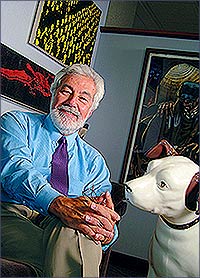


 |
 |
Issue Contents : : Feature Stories : : Curator of the Curious : : Page [ 1 2 3 ]
Curator of the CuriousFamed Spy Museum builder Dennis Barrie drops his cover to reveal secret strategies for educating the public.
 |
|
| Dennis Barrie | |
Can Dennis R. Barrie '70 supply us with the answers?
Well, right now he's laughing out loud. He's also patting the head
of his three-foot-tall plastic dog, Nipper, the beloved advertising icon made
famous by RCA. Elvis Presley kept a large plastic Nipper at his Graceland mansion,
which Barrie came across while building the Rock and Roll Hall of Fame and Museum
in Cleveland eight years ago. Now Barrie keeps a replica of Nipper in his own
office, and he pats its head frequently.
"I'm afraid I can't help you with Oswald," says Barrie,
a nationally renowned cultural historian who masterminded the recent creation
of the International Spy Museum in Washington, D.C. "You know, so much
of history remains an enigma, in spite of our best efforts. A mystery.
"I love the way history keeps revealing itself, over time," he adds. "People
come forward with new information, and that information changes our understanding
of past events. We learn new bits and pieces. What I find utterly fascinating,
as I get older, is how much I don't know. Pursuing the questions--that's
what I find interesting and stimulating--trying to learn more and more about
the reality behind historical events."
I nod and deliberate. What's the best question to ask a famed museum creator
at this key point in an interview?
"Dennis…I was wondering. Do you read a lot of Franz Kafka?"
He laughs again. "Interesting that you should ask. I attended an amazing
Kafka exhibition at the Jewish Museum in New York less than a year ago. And I
picked up this Kafka finger-puppet. Here, I'll show you."
He gives the dog's head a final pat, then walks across his large, cluttered
office to a bookcase. A moment later, he's back, waggling the tiny puppet
at the end of one finger.
"Franz Kafka," he says.
The dark, somber head of the great 20th-century surrealist writer bobs and dips, bobs and dips, as Barrie manipulates his brooding image at will. "I love Kafka because of the way he keeps posing questions and exploring possibilities," he says. "At the Spy Museum, our goal is to give visitors the broad outlines of the history of espionage. We can't offer much more than that, really. Just the skeleton.
"I do think that history can accomplish that much. It can give us an accurate outline," he adds. "But in the end, it's really the stories we're after, not the explanations. We want the stories to be true, of course--and the facts we present at the museum are 100 percent accurate. But facts alone can never give us final answers. What matters most to me, as a creator of museums, is the mystery involved. The poetry. The legends that lie behind the facts."
He sits down. He starts patting Nipper's head again. "I guess it's fair to say that I'm both a historian and an entertainer. A showman. And I like it that way. I really enjoy the challenge of trying to bring history alive for people with images and displays and all sorts of interactive exhibits that try to get at the mystery behind events."
The Historian As Entertainer
At 56, Dennis Barrie has become not just one American legend, but several.
As a co-creator and the executive director of the hugely popular Rock and Roll Hall of Fame and Museum in Cleveland from 1993 to 1998, he's an internationally sought-after expert on American pop culture. His take on the birth of the museum? "We tried to capture some of the magic, some of the power of rock, and I think we got it right."
As the controversial director of the Cincinnati Arts Center from 1983 to 1992, Barrie was criminally prosecuted (and eventually acquitted) for launching a 1990 exhibition that featured several homoerotic photographs by the late Robert Mapplethorpe. To many, he is an authentic First Amendment hero. Eventually fired by the Cincinnati museum, the fearless art historian (he holds a PhD from Wayne State University) risked his career and his personal safety--while facing several anonymous death threats--to battle the forces of censorship and defend free speech. Today he says quite simply: "I did what I thought was right, that's all. I knew I'd be punished for it, and I was. But it was the right decision."
As president since 1998 of the Cleveland-based Malrite Com-pany,
which specializes in creating for-profit, theme-based museums around the
United States, he's
been a key player in the creation and day-to-day management of the Spy
Museum,
located less than a block from FBI headquarters in downtown Washington.